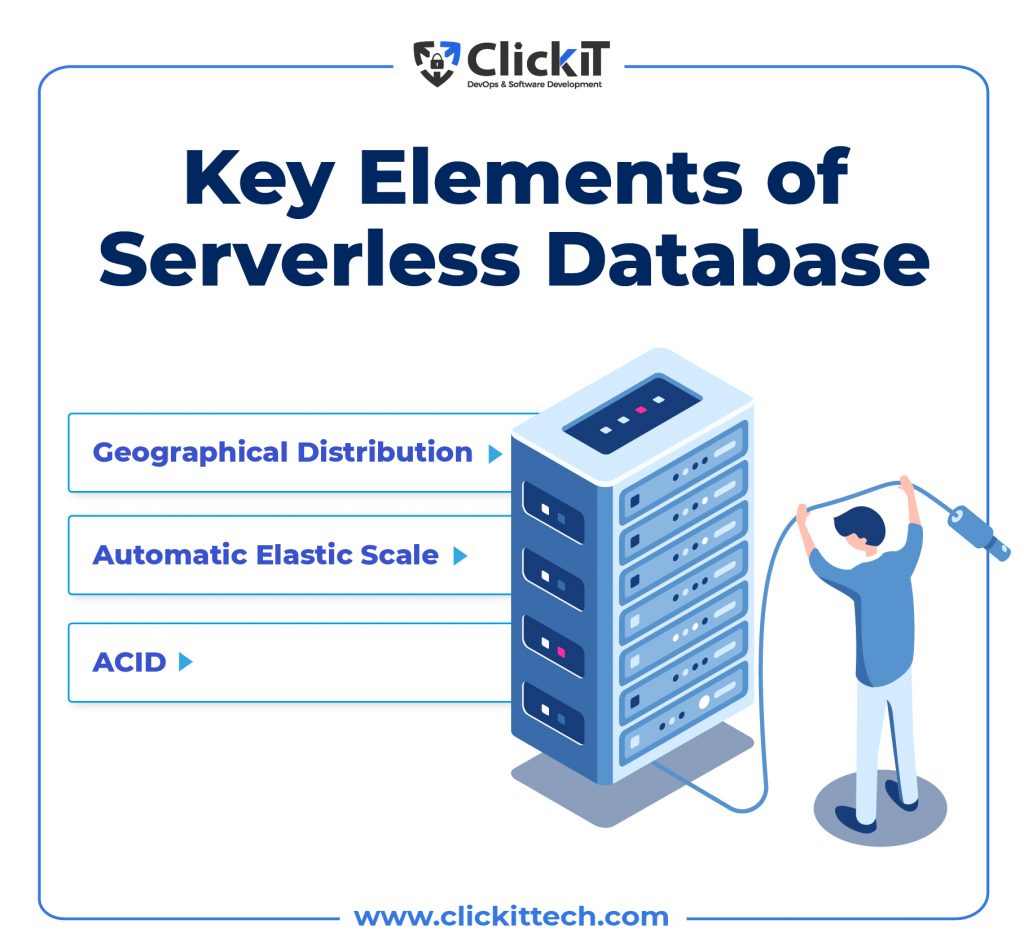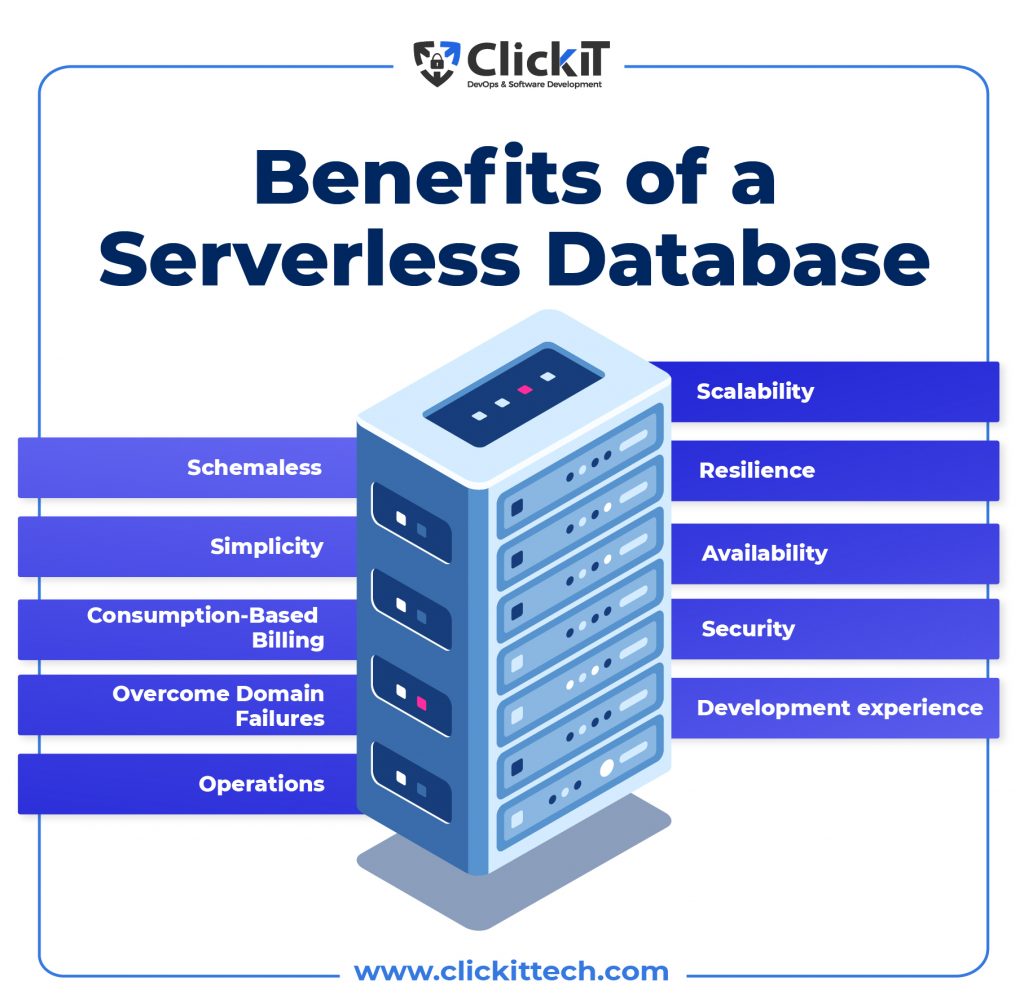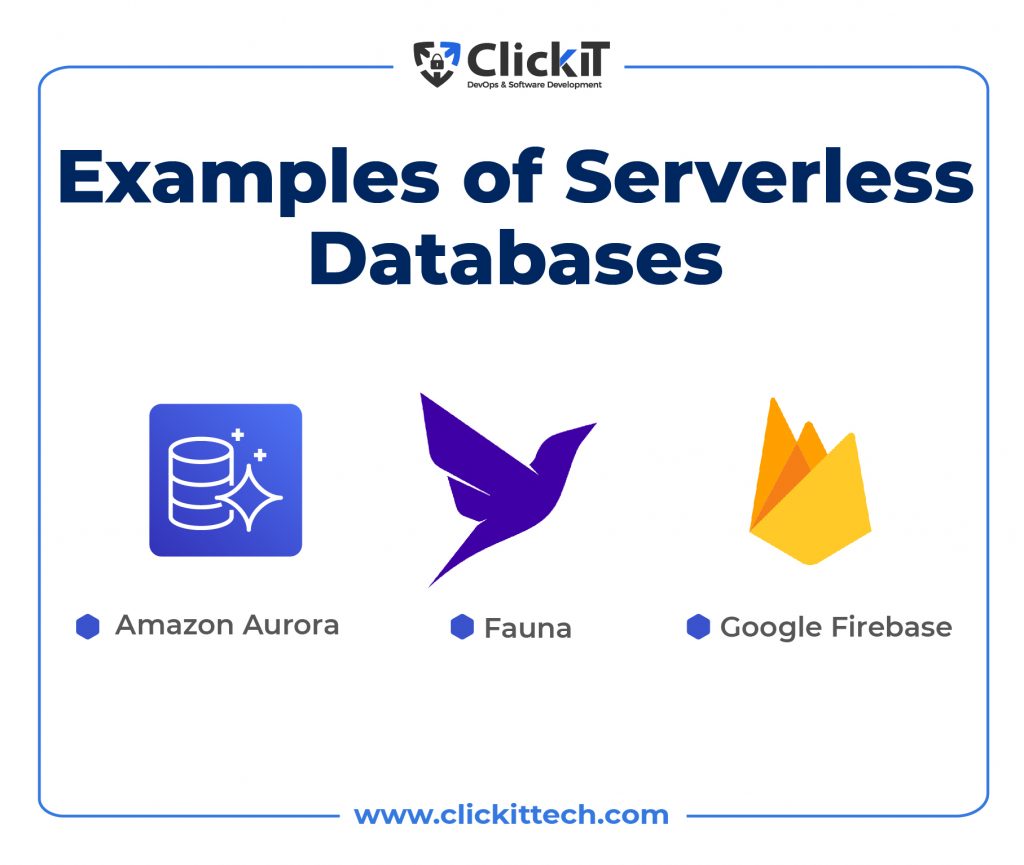A serverless database combines standard database functions with the values of a serverless architecture database, like an AWS serverless database. As a developer, when you take on a new project, one of the key decisions you might need to make is which kind of database you should use.
Moreover, a serverless database abstracts the majority of a database’s complexity into a simple cloud-based API. In light of the foregoing, serverless databases can provide businesses with more automatic scalability, more resilience, and a shorter time to market.
Back when they were building and deploying apps, developers required particular hardware to handle databases. The procedure was time-consuming, as developers had to wait for the server to arrive before manually unpacking, installing, wiring, configuring, and deploying programs. Traditional database systems introduced over 20 years ago require complicated sharding and intensive operational administration. This eventually raises the costs associated with the development of vital applications.
The serverless strategy has gained popularity these days owing to its high transparency, quicker performance, cost-effectiveness, immediate availability, and large-scale operational infrastructure support.
This blog article will give you a good idea of what serverless architecture databases are, serverless architecture, their workflow, and the benefits of using AWS Serverless Database for your next project to avoid losing money and time for making a wrong choice.
- What is a Serverless Database?
- How Does a Serverless Database Work?
- Benefits of a Serverless Database
- Why Should You Use a Serverless Database?
- When Should I Use a Serverless Database?
- Examples of Serverless Databases
- Conclusion of Serverless Database
- FAQs
What is a Serverless Database?
A serverless database allows developers to create apps that use infrastructure without specialized hardware. It handles the changing demands of an application and manages unpredictable workloads which cannot be foreseen or scheduled.
There are several advantages to serverless computing, including spending only on the resources you utilize, scaling up and down to meet demand, removing the necessity to maintain servers, and cutting expenses. The most important feature of a serverless database is its flexibility in adapting capacity based on workload.
A serverless database follows the core principles of a serverless computing paradigm. This paradigm includes key elements that a serverless architecture database conforms to. Some of these elements will be discussed below.

Automatic, Elastic Scale: Thanks to elastic scaling, your service or app may use the correct amount of resources for your task needs at any moment. The elastic scale is automatic. Therefore, there is no need to modify your app, and it will assist in minimizing computation expenses.
Geographical Distribution: A serverless database allows you to replicate various datasets across the globe without any extra tooling or specialized programming. Different protocols integrated with the serverless database networking layer ensure that errors and performance degradation are handled effectively.
ACID: Scaling does not need to come at the expense of consistency. Some serverless architecture databases provide the necessary atomicity, consistency, isolation, and durability (ACID) qualities to your transactions, regardless of scale, without sacrificing performance.
You can read more about the history of database management here.
How Does a Serverless Database Work?
The serverless computing paradigm has a concept of separate storage and processing. You construct an endpoint, choose the maximum and minimum capacity, and send queries. This endpoint acts as a proxy for database resources that are dynamically scaled. This allows your connections to stay intact while scaling actions occur behind the scenes.
This storage and processing separation also saves space. You may scale down to zero operations and pay only for storage. Scaling occurs in less than 5 seconds whenever your application requires it. This happens while relying on a pool of resources eager to service your requests.
Benefits of a Serverless Database
Scalability
As we know, serverless databases can be scaled up or down at any moment, as they start and stop according to the application’s needs. For instance, some databases will scale the computing units to accommodate the load if your functions are querying and reading to the same database cluster. As a result of this automation, your data will be consistent, and all functions can run in parallel.
Resilience
A serverless application will withstand the loss of any backend computing instance and any other network or physical problem. This resilience ensures your service is always available, even during an upgrade.
Availability
One of the fundamental difficulties with any serverless computing platform is that it must guarantee that a service is available and that the service is rapidly accessible anytime it is asleep. Putting an unused service to sleep results in fewer costs related to computation. That said, it should be available immediately when you need it again.
Security
When it comes to quick application development, keeping your database safe in today’s virtual era is critical, seeing as apps are becoming increasingly vulnerable to cyber threats. Services that provide databases are also accountable for protecting all cloud components and operating system vulnerabilities, like an AWS Serverless database.
However, because developers are responsible for constructing applications by defining application logic, code, data, and security-related layered settings, using serverless introduces additional security concerns. When employing a serverless database, the system controls resources, monitors all operating servers, controls OS patches, automatically removes any compromised server, and deals with its negative counterpart.
Read our blog about the Top 10 Best AWS Security Practices.
Development experience
When utilizing an AWS serverless database, developers don’t need to worry about procuring, configuring, or maintaining database infrastructure. Developers need to focus on designing apps. This boosts productivity and results in a better user experience.
Schemaless
You can manage any data output from your functions using Schemaless. This technique makes integrating serverless databases into your functions a breeze.
Simplicity
Accessing your database is as simple as using an API. A serverless database makes life easier for everyone who interacts with it. It provides capabilities such as self-service starts, entirely controlled functions, and the ability to build clusters with the click of a button or a single command.
Consumption-Based Billing
Since their charges are based on consumption, AWS serverless databases are cost-effective. You do not need to pay for storage. Instead, you only pay for the resources you actually utilize. It is also possible to establish a spending limit should you want to minimize budget overruns.
Overcome Domain Failures
A serverless system will most probably be offered in several areas. This is quite straightforward when no persistence is required. However, if you need any form of assurance with respect to data accuracy and accessibility, the program faces a big barrier. To minimize failures resulting from the failure domain, a serverless database should keep multiple copies of all data and proactively regulate where the data lives. Data placement should be controllable and automatic by default to enhance availability.
Operations
Generally speaking, a serverless database is more adaptable than a conventional one. This is mostly because some traditional software maintenance responsibilities are simply unnecessary. For example, you don’t need to hire a support team or specialized maintenance experts to maintain the infrastructure, as this is the cloud provider’s responsibility.

Why Should You Use a Serverless Database?
Security: Misconfigured apps are one of the most serious concerns related to serverless technology. For instance, if you’re migrating to an AWS serverless database, you should specify various permissions for your application. This will define how it interacts with other AWS services. When permissions are ambiguous, a service can allow for more rights than is necessary for security breaches in the serverless database on AWS.
Cold Starts: Handling cold starts is one of AWS serverless databases’ most significant and troublesome aspects. Whenever a serverless database is unused, it simply sits idle to conserve resources and prevent wasting performance. When the system switches on, it takes a while to relaunch all of the underlying processes. If you are the first user to engage with the system after it has been cold-started, you may encounter extended delays and response times.
Debugging: With serverless systems, you need to monitor and identify performance issues or resource misuse closely. This is owing, in large part, to the fact that cloud solutions are rarely open-source. Moreover, utilizing a debugger, profiler, or APM tool to debug a system is difficult and rarely successful. You should, therefore, explore third-party tools, which are growing on the market right now.
Vendor Lock-In: When switching to a different provider, choosing a serverless approach may result in some issues. This is mainly because each supplier has key qualities and procedures that differ. You can read more about how to avoid vendor lock-in here.

When Should I Use a Serverless Database?
- When you use applications infrequently.
- When you are testing or experimenting.
- When you have variable workloads.
- When you need to minimize operations.
Let’s dive a little deeper into these situations.
When you use applications infrequently.
Let’s say you have a website with a low volume, and you wish to pay only for the time a person accesses your site. This is possible, seeing as you pay per second for the database resource you utilize. With traditional database servers, you only pay for the required servers for your workloads. This isn’t great if you aren’t using all of the storage and computing capabilities of the computers you are paying for. There are no refunds. The opposite is also true. If you are spending on a specific number of computers and your workload exceeds their capacity, the performance of your application will suffer.
Serverless databases address both of these issues by having you pay for real storage and computation rather than for the hardware. This is feasible by combining a serverless architecture with elastic scalability.
To sum up, serverless databases provide more dependable database performance at a lower cost for many consumers. Serverless architecture databases aren’t always the best option for every application. Nevertheless, due to their pay-for-what-you-use structure, they are a viable approach for reducing database expenses for a broad range of applications.
When you are testing or experimenting
Seeing as they are self-service and quick, serverless databases are ideal for lightweight programs, prototypes, testing and development environments, side projects, and so on.
The entire procedure is self-serve, making it ideal for trials, side projects, and sorting out faults before investing money. You may also incorporate it into your usual prototyping process or utilize it for testing in your CI pipeline.
When you have variable workloads
Applications such as HR, planning, operations monitoring, and so on have unpredictable peak periods, making instance reservations impracticable. These are examples of variable workloads. However, you don’t need to offer peak or average capacity with a serverless database.
Moreover, serverless particularly addresses the cold start problem by utilizing a novel design that allows for an inactive database to require zero computational resources while remaining instantaneously ready in the event of a request.
This makes it an excellent alternative for any application with on/off use patterns, as it assures that you are not utilizing computational resources unless required.
When you need to minimize operations
Typically, companies with database-containing operations have to choose between scaling with a NoSQL database at the expense of losing transactional integrity and acquiring a new unique query language or retaining transactional consistency and SQL familiarity but spending significant operational labor to scale via manual sharding.
Serverless computing allows developers to avoid this decision. With automatic scaling and resilience, it provides the operations-free scaling feel of NoSQL without sacrificing ACID transactions and other SQL database benefits.
In practice, this means that you and your team can spend less time thinking about the database and far more time developing your application. This makes serverless databases an excellent solution for any software development company that wishes to concentrate on development, all while eliminating the load of database operations.
Examples of Serverless Databases
Several serverless database alternatives on the market, such as Serverless Database AWS, can be very useful to you while developing your serverless application. The following databases are among those that provide the most amazing features as serverless architecture.

Serverless Database: Amazon Aurora
Amazon Aurora Serverless v2, which is currently in preview, is an AWS serverless database that grows at a rate of thousands of transactions per second. It changes capacity in perfect increments seeing as it scales to deliver precisely the correct number of database resources required by the app. There’s no database capacity to maintain, and you only pay for the capacity used by your application. When compared to the expenses related to providing capacity for peak traffic, Amazon estimates that you can save up to 90% on your database costs. Moreover, Amazon Aurora Serverless v2 supports MySQL.
Aurora, as an AWS Serverless database, differs from standard RDBMS alternatives in two ways. First, it offers a payment scheme dependent on usage and a Data API, enabling you to send HTTP database requests.
Concerns with server-based RDBMS include connection serverless architecture being a bad match, payment mechanisms not based on consumption, and it being an odd choice with infrastructure-as-code. Using infrastructure-as-code, you can thoroughly specify your infrastructure, allowing it to upgrade in a regular, repeatable manner.
Two out of these three concerns are addressed by the enhancements of Aurora Serverless. You get something more in sync with the average serverless architecture when you employ a pay-per-use charging model. While the payment model modification is intriguing, the Data API is the true game changer when it comes to this AWS Serverless database.
The Aurora Serverless Data API allows you to perform HTTP calls to an RDBMS database. There is no requirement for continuous TCP connections. Furthermore, it will manage connection sharing for you, thus eliminating the need for you to consider connection restrictions in a Lambda function.
Serverless Database: Fauna
Fauna is a flexible transactional database that comes with a safe and scalable cloud API that supports native GraphQL. It combines the versatility of NoSQL systems with the relational querying and transactional features of SQL databases. It guarantees full ACID compliance and supports drivers for Python, Java, Scala, and GraphQL.
When organizations upgrade their OLTP infrastructure using Fauna, developers no longer have to worry about database deployment, partitioning, scalability, replicating, or management. If you’re creating new microservices or extending or upgrading current apps, Fauna is a great option for you, as it simplifies coding and speeds up delivery.
It is simple to establish with no scaling limitations and cold starts. Furthermore, it allows for the creation of user-defined functions with conveniently accessible business logic.
Finally, its security makes use of third-party services such as Auth0, which provides the option to distribute data consistently in selected regions.
Serverless Database: Google Firebase
Using a cloud-hosted, NoSQL database, Firebase Database allows you to store and sync data among users and devices in real-time. Cloud Firestore, unlike a SQL database, does not have tables or rows. Instead, data is stored as papers arranged into collections. Each document has a collection of key-value pairs. Within milliseconds, the new data syncs across all linked devices. Furthermore, data is accessible even if your application is offline, ensuring a pleasant user experience regardless of network availability.
Cloud Firestore is specifically designed to store massive amounts of tiny documents. Collections must be used to hold all papers. Documents may include subcollections and nested objects, each containing simple fields such as strings or complicated objects such as lists.
Serverless vs Containers: Don’t miss the full battle.
Conclusion of Serverless Database
Nowadays, companies are transitioning towards data-driven and automated processes with improved data management capabilities, allowing for speedier development of software applications and market launches. Broadly speaking, today’s business-critical applications require a data architecture that enables automatic scaling, quicker performance, zero downtime, different data models, security, immediate availability, and more. All of this is provided by serverless architecture databases.
You can avoid numerous common issues arising in traditional setups using a serverless database, such as the AWS serverless database. You also save money, seeing as you only pay for the resources that you actually use. Furthermore, you don’t waste any time there is no patching, procuring, or maintaining of servers. A serverless database also increases security by requiring all apps that interact with the same data set to use the same access control, therefore minimizing the attack surface. A serverless architecture database may be used for prototype testing, automatic website scaling, and continuous integration/ deployment processes.
If you are a startup or enterprise company requiring comprehensive solutions, including unique cloud project analysis, consulting, design, and execution, contact us now!

FAQs
Although the name suggests so, servers are still utilized to run code. However, they are stored and maintained by cloud providers. The expression “serverless” refers to the customer’s experience as a whole, which is free of maintenance and interaction with servers.
One of the primary benefits of going serverless is the lower cost due to the elimination of the requirement for always-on servers. Companies may also benefit from infinite cloud scalability, more flexibility, and quicker deployments, which lead to faster innovation and speed to market.
Amazon Aurora, Fauna, and Google Firebase.
Security is one of the main worries of professionals seeing as there is limited knowledge of serverless security, especially when compared to traditional systems. The modularity of serverless apps may expand the attack surface. Furthermore, because data is constantly transferred between third-party elements and serverless operations, it is vulnerable to interception.
A serverless SQL database, for example, allows you to handle large datasets using SQL language without having to manage servers, operations, capacity planning, and so on.
The different types of serverless databases are:
-Relational Databases, like Amazon Aurora Serverless and Azure SQL Database Serverless.
-NoSQL Databases, such as Amazon DynamoDB and Azure Cosmos DB.
-Document Databases, Firebase Firestore, Amazon DocumentDB.
-Graph Databases, such as Amazon Neptune and Azure Cosmos DB with Gremlin.
-In-memory databases, such as Redis Labs (Redis Enterprise Cloud) and AWS ElastiCache (for Redis).







